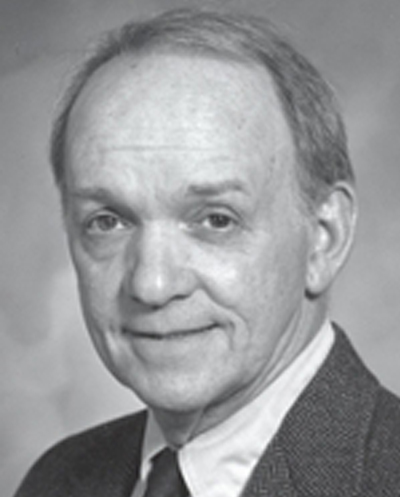
Drs. Paul Bray and James Kushners' Reflections on George Cartwright
Dr. Paul Bray's Reflections on Dr. George Cartwright
Most of us, when we ponder our lives and careers, can identify a small number of transforming events and individuals that had major impacts on early choices that became the foundation for a long professional life. As a 2nd year medical student at the U of U in 1975 I had only a vague vision of my future. Rather than working to refine my goals, I seemed to prefer attending RDT and Ballet West dance concerts. Without being fully aware, my focus began to develop when I was selected into Honors Medicine – a program of 10 students who had decided to do an Internal Medicine residency. We were expected to select a faculty mentor who would guide us and supervise a one-month research project. I broke the rules and instead selected Corwin Edwards, who was Chief Medical Resident at the time. Corwin was intensely involved with Dr. Cartwright, who was “Mr. Iron Metabolism and Mr. Hemochromatosis.” Saying I was in awe of Dr. Cartwright would be an understatement. I had never worked with any clinician-scientist, let alone a professional with an international reputation. He managed the rather impossible task of identifying a lab project that a completely inexperienced student could complete in one month. It involved a beautifully clear and simple hypothesis regarding the molecular basis for hemochromatosis, and a relatively easy technical assay to master (tube gel electrophoresis, currently extinct). In addition, Dr. Cartwright wanted to develop an assay for diagnosing early-stage hemochromatosis in family members. I drove to Vernal, injected an iron-chelator intra-muscularly into young family members and collect urine samples for iron measurement. Although these small projects never transformed patient management, they were both great examples of creative and clinically-relevant research.
I have several more personal memories of Dr. Cartwright. In 1976 he and his wife graciously hosted a dinner at this home for the Honors Medicine students. Dr. Cartwright and the Utah Hematology Division had had a long-standing connection to Internal Medicine and Hematology at Johns Hopkins. The guest of honor was Victor McKusick a Hopkins faculty and the Father of Medical Genetics. One of my classmates, Mary Ann Ware, asked him if he had any hobbies. He thought for a few moments and replied, “No, not really.” This was my first realization that attainment of academic success required intense focus. But as the evening progressed, we also learned from Dr. Cartwright that success did not mean all work, all the time. He explained that every year, he and his son went on a long camping trip. Several months earlier, they had spent two weeks in the Alaskan wilderness, hiking the region and encountering a pristine environment, much wildlife, but no humans. They arrived in this extremely isolated area via a seaplane that landed on a lake. I still remember feeling a bit of a chill when Dr. Cartwright said that after unloading their gear the pilot told them “Be here in two weeks,” and then took off.
Indeed, my exposure to Dr. Cartwright was profoundly impactful on my career. (He also single-handedly got me into my Medicine Residency – but that is another story). I didn’t fully appreciate it at the time, but his career has been a role model for my own exceptionally satisfying professional and personal life. I learned that hard work and focus pay huge dividends, but you can still go to the occasional dance concert.
Dr. James Kushner's Reflections on Dr. George Cartwright
This year marks the 70th anniversary of the appointment of George E. Cartwright to the faculty of the Department of Medicine at the University of Utah School of Medicine. Dr. Cartwright was born in Lancaster, Wisconsin on December 1st, 1917. He earned his BS degree at the University of Wisconsin where he first became interested in nutrition and the roles of metals and vitamins in mammalian metabolism. He received his MD degree in 1943 at Johns Hopkins. He made his first contact with Dr. M.M. Wintrobe as a medical student at Hopkins and had his first research exposure in the Wintrobe laboratory. Dr. Wintrobe came to Utah in 1943 to become Chair of the Department of Medicine and to lead the transformation from a two year pre-clinical school to a four year, full fledged medical school. One of Dr. Wintrobe’s first house staff recruits was Dr. Cartwright who came to Utah as a resident in medicine in 1944. Dr. Cartwright, in addition to his clinical training, continued his research training in the Wintrobe laboratory where he began his studies of iron uptake and transport, disordered iron metabolism in the anemia of chronic disease and the interactions between copper and iron metabolism. Dr. Cartwright was drafted into the U.S. Army in 1945 and spent most of the next two years as a medical officer in China.
Dr. Cartwright returned to Utah in June, 1947 with an appointment as an instructor in Medicine. His research productivity was impressive and he was promoted to assistant professor in 1948. His deep understanding of the scientific method and his ability to create animal models of hematologic disorders in humans led to his appointment in 1950 as the first chief of the newly created Division of Hematology. He and Dr. Wintrobe developed the first broadly based hematology training program that combined clinical and research training. He continued his insightful studies of iron and copper metabolism and began comprehensive phenotyping studies of large Utah families with hereditary hemochromatosis and Wilson’s disease. Dr. Cartwright’s focus on inherited diseases proved to be a critical factor in developing the programs in human genetics that have flourished at the University if Utah.
Dr. Cartwright became chair of the Department of Medicine in 1967. By the 1970’s the field of genetic epidemiology was rapidly expanding and in 1978 the concept of linking polymorphic DNA markers to disease phenotypes was developed. A young investigator in the field, Mark Skolnick, PhD, was recruited to Utah by Dr. Cartwright and others. Cartwright and Skolnick developed a close personal relationship and began extensive studies in families with hemochromatosis. These studies defined the laboratory and clinical phenotypes of the disease, established the Mendelian mode of disease transmission and mapped the location of the hemochromatosis gene to the HLA region on chromosome 6. Cartwright recognized the need to recruit an investigator who could focus on the development of accurately mapped, highly polymorphic DNA markers to further the linkage approach to inherited diseases. Funding was obtained from the Howard Hughes Medical Institute and in early 1980 Ray White, PhD was invited to establish a laboratory in Utah and launch an effort designed to develop hundreds of polymorphic DNA markers and map them to chromosomes with sufficient density to permit localization and isolation of disease causing genes through linkage to the polymorphic DNA marker. Genetics in Utah was now firmly established.
Dr. Cartwright’s interest in the genetic basis of human diseases led him to resign his position as chair of the Department of Medicine in 1980 with plans to devote the rest of his research career to studying the genetic basis of hemochromatosis and other disorders of metal metabolism. This plan did not come to fruition because of his tragic death from a myocardial infarction on Easter Sunday, 1980. He was 62 years old as was his father who also died of a myocardial infarction.